Do you know how to make Pierogi? Buttery, crisp Polish Pierogies stuffed with potatoes, cheese, and sauerkraut are a holiday favorite from the very first bite for everyone who tries them.
There are a lot of steps to this Pierogi recipe but don’t let that intimidate you. Anyone can make these! I recommend diving in and making a big batch at one time, so you can freeze some for later.
It’s also a ton of fun to turn Pierogi making into a big event. Grab friends and family and spend an afternoon rolling, stuffing and cooking these delicious dumplings together.
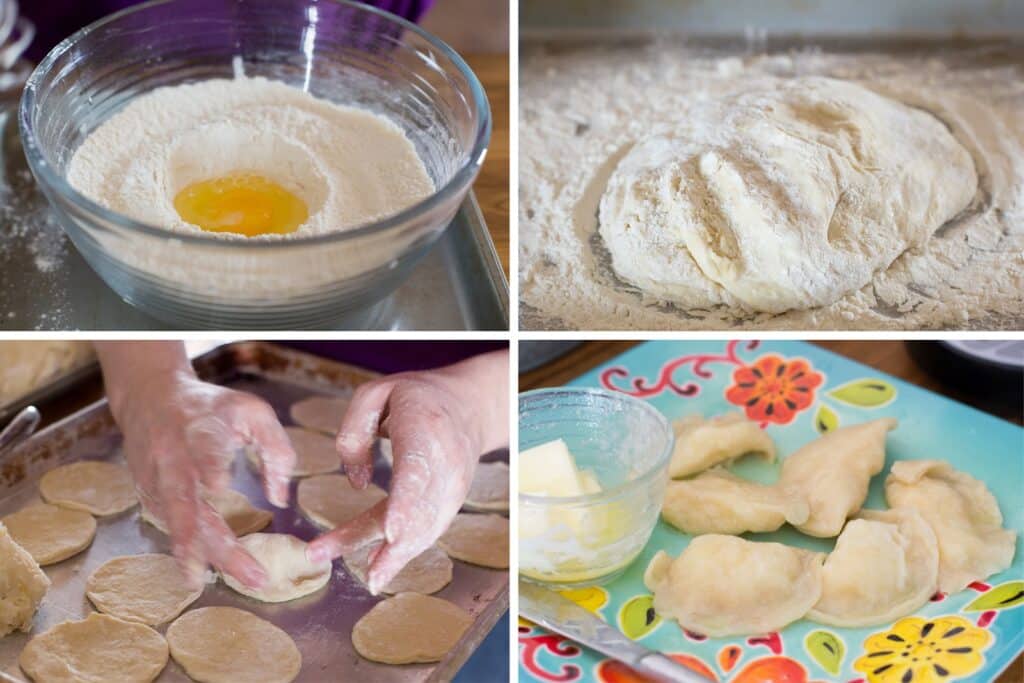
My sister Jenny taught me how to make Polish pierogies years ago; the same way that her Mother-In-Law Jane taught her to make them. Last time we were together for Christmas, we made a double batch of these pierogies and our small crowd ate almost all of them!
Side note: Did you know that the plural for pierogi can be pierogies OR just pierogi? I clarified that with Jane before sharing this recipe for the first time five years ago. And Webster dictionary has confirmed it once again. (Perogies is another spelling I often see, but that one is not in the dictionary.)
Despite the over-explanation here, I know that many of you will still email me to tell me that there is only one way to spell pierogi and I am doing it wrong. All in a day’s work, my friends. I can’t win them all.
What is a Pierogi?
Pierogies are a dough dumpling traditionally stuffed with potatoes, cheese, and/or sauerkraut. First boiled and then fried in butter, these little potato-filled pockets are irresistible.
I’m including our family’s favorite combination of potato, cheese, and sauerkraut in the recipe below. We serve these pierogies with Polish Kapusta and everyone loves the combination.
I’m told that while Jane was growing up, it was common to ask your guests ahead of time whether they preferred potato/cheese or sauerkraut/cheese pierogies. Many people are very particular about their pierogi fillings!
I discovered this for myself when I asked how you all like your pierogies! There are countless other filling options: meats, fruits, vegetables, the combinations are endless.
How To Make Pierogi
Making homemade Pierogi starts with a great filling. Simmer peeled, cut potatoes in a pot of water for 15 minutes until fork tender. Mash the cooked potatoes, then stick them in the fridge to cool completely.
While the potatoes cool, saute the chopped onion in a little olive oil until softened. Add the onion and oil to the cooled potatoes along with the sauerkraut and cheeses.
We learned how to make pierogies with Farmer’s cheese, a pot cheese that comes in a container and is very soft. If you can not locate farmer’s cheese in your market, you can substitute 2 ounces shredded Monterrey jack and 2 ounces ricotta cheese.
Store the filling in the refrigerator until your dough is ready.
Tip: To save time on the day you’re making and serving your pierogies, make the filling a day or two in advance then keep it sealed tight in the fridge until ready to use.
We find it easiest to rotate in batches of six to manage the process most efficiently. 6 waiting, 6 boiling, 6 cooling, 6 frying, repeat. It sounds a little overwhelming initially, but once you have a little assembly line set up, it goes fairly smoothly. We fill 18 pierogies before starting the first batch boiling and then just keep rotating through the stages.
This is a half recipe and it can easily be multiplied for a crowd. We’ve found that this amount is much more manageable, especially for the first few times we made these.
Pierogi Dough
Pierogi dough is a simple mixture of flour, egg, water and just a touch of salt, not unlike homemade fresh pasta.
After mixing together the flour and salt, crack an egg into the center of the bowl and combine with the flour mixture. Gradually add hot water to the bowl until your dough is soft and slightly sticky.
If the dough appears too wet, add more flour a tablespoon at a time. Likewise, if the dough is too crumbly and dry, add more hot water a little at a time.
Chill the dough in the refrigerator for an hour or so until cool and firm.
Pierogi Recipe
- Here comes the fun part. You get to roll out the dough, shape and stuff your pierogies, then give them a bath in boiling hot water.
- Start the water boiling on the stove while you get all your ingredients out of the fridge and ready. Make sure to have a counter space or table cleaned and cleared so you can put the pierogies together without interruption.
- First, divide the dough into four sections. Roll the first section out until it’s very thin, about ⅛ inch in thickness. Cut this section into circles, then place a tablespoon of the potato filling on each side.
- Fold the circles over and pinch the edges to seal. Repeat this with the other sections of the dough and then place your prepared pierogies in a single layer on a plate or pan.
- Plop the dumplings a few at a time into the boiling water. If they stick to the bottom of the pot, give them a quick nudge with a spoon or spatula. When the pierogies rise to the top, scoop them out with a slotted spoon and place them on a buttered plate to cool for a few minutes.
- Once slightly cooled, it’s time to fry your waiting pierogies in butter. Fry a few at a time until the edges are brown and crisp.
Pierogi Making Tips
If you have a team of folks working in the kitchen, you can set up an assembly line to make finishing these steps quicker and easier. Have someone assembling the dumplings, someone boiling, and someone frying.
We find it easiest to rotate in batches of six to manage the process most efficiently. 6 waiting, 6 boiling, 6 cooling, 6 frying, repeat.
We fill 18 pierogies before starting the first batch boiling and then just keep rotating through the stages. The recipe below has been halved from Jane’s original recipe and it can easily be multiplied for a crowd. We’ve found that this amount is much more manageable, especially for the first few times we made these.
You’ll be ready to sit down to a delicious, buttery plate full of Polish Pierogies in no time. These are satisfying enough all on their own as a snack, appetizer or even a meal.
Pierogies pair especially well with cabbage dishes like this Cabbage and Sausage Skillet, Layered Cabbage Rolls, White Beans and Cabbage, or this Spicy Cabbage.
This recipe includes my family’s standard filling of potato, sauerkraut, and cheese but you can use this same recipe as a guideline for cooking Pierogies with any kind of filling you like.
Leftover pierogies freeze like a charm, too! Place them on a single layer on a cookie sheet until just frozen (an hour or two) before sealing them in airtight containers and storing in the freezer.
Kitchen Tip: I use this pot, this pan, and this spider to make this recipe.
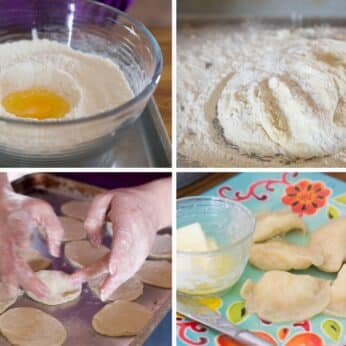
Polish Pierogi Recipe: Step-By-Step Recipe with Photographs
Ingredients
FILLING INGREDIENTS
- 4 medium size potatoes any variety will work, peeled and cut into 1″ pieces
- 1 teaspoon olive oil
- 1/2 small onion chopped small about ⅓ cup
- 1/2 14 ounce can sauerkraut
- 4 ounces farmer’s cheese *
DOUGH INGREDIENTS
- 2 1/2 cups all purpose flour plus more for kneading
- 1 teaspoon kosher salt
- 1 large egg
- ¾ – 1 cup very hot water
FOR SERVING
- 3/4 cup butter melted
- Toppings: sour cream applesauce
Instructions
FILLING INSTRUCTIONS
- Place the potatoes in a large pot and cover with water. Bring to a boil and then simmer until fork tender, about 15 minutes. Drain the water and mash the potatoes. Place the potatoes in a mixing bowl and chill in the refrigerator until cold.
- In a small skillet over medium heat, warm the oil and then saute the onion until tender. Let them cool for a few minutes and then add the cooked onions to the bowl of cold mashed potatoes. Place the sauerkraut in a strainer and rinse very well under running water, for at least 3 minutes. Drain thoroughly and add the sauerkraut to the bowl with the potatoes. Add the cheese and stir to combine. Store in the refrigerator until ready to make the pierogies. The filling can be made a day or two in advance and refrigerated until needed.
DOUGH INSTRUCTIONS
- Place the flour and salt in a large bowl and stir to combine. Make a small well with your hand and crack the egg into it. Stir to combine and then gradually add the hot water, mixing with your hands until the dough is very sticky and well combined. If it becomes too sticky and wet, add just a tablespoon or so more flour. The photo on the left is too wet, the one on the right (with the spoon in the bowl) is perfect. Chill the dough in the refrigerator for at least an hour.
COOKING INSTRUCTIONS
- Bring a pot of water to a boil. Sprinkle a large board with flour. Transfer the dough to the floured surface and flip it over a few times to coat with flour. Gently knead the dough just a few times with your hands, adding a sprinkling of flour as needed.
- To Shape Pierogies: Divide the dough into four sections and roll out one of the sections very thin, to about 1/8" thickness. (This should be just a bit thinner than a pie crust.) Cut into circles and place 1 tablespoon of the potato filling on one side. Fold over the circle and pinch around the dough. Place the prepared pierogies in a single layer onto a waiting plate. Don't stack them or the dough will stick together.
- To Boil Pierogies: Drop the waiting pierogies into the water, a few at a time. Use a spoon or spatula to gently nudge them off the bottom of the pot if they stick. When they float to the surface of the water, lift them out carefully with a slotted spoon. Place them on a buttered plate and drizzle a small amount of melted butter on top of them to prevent sticking together. Let the boiled pierogies cool for a few minutes before frying them.
- To Fry Pierogies: In a large skillet over medium heat, melt a tablespoon of butter. When the butter sizzles, place the boiled pierogies in the skillet in a single layer. Let them cook 2-3 minutes, until lightly browned on the edges, flip over and repeat. The pierogies will not turn brown all over, but the edges should crisp and be light brown. Remove the finished pierogies to a buttered baking dish.
Notes
Nutrition
{originally published 2/20/14 – recipe notes and photos updated 8/12/21}

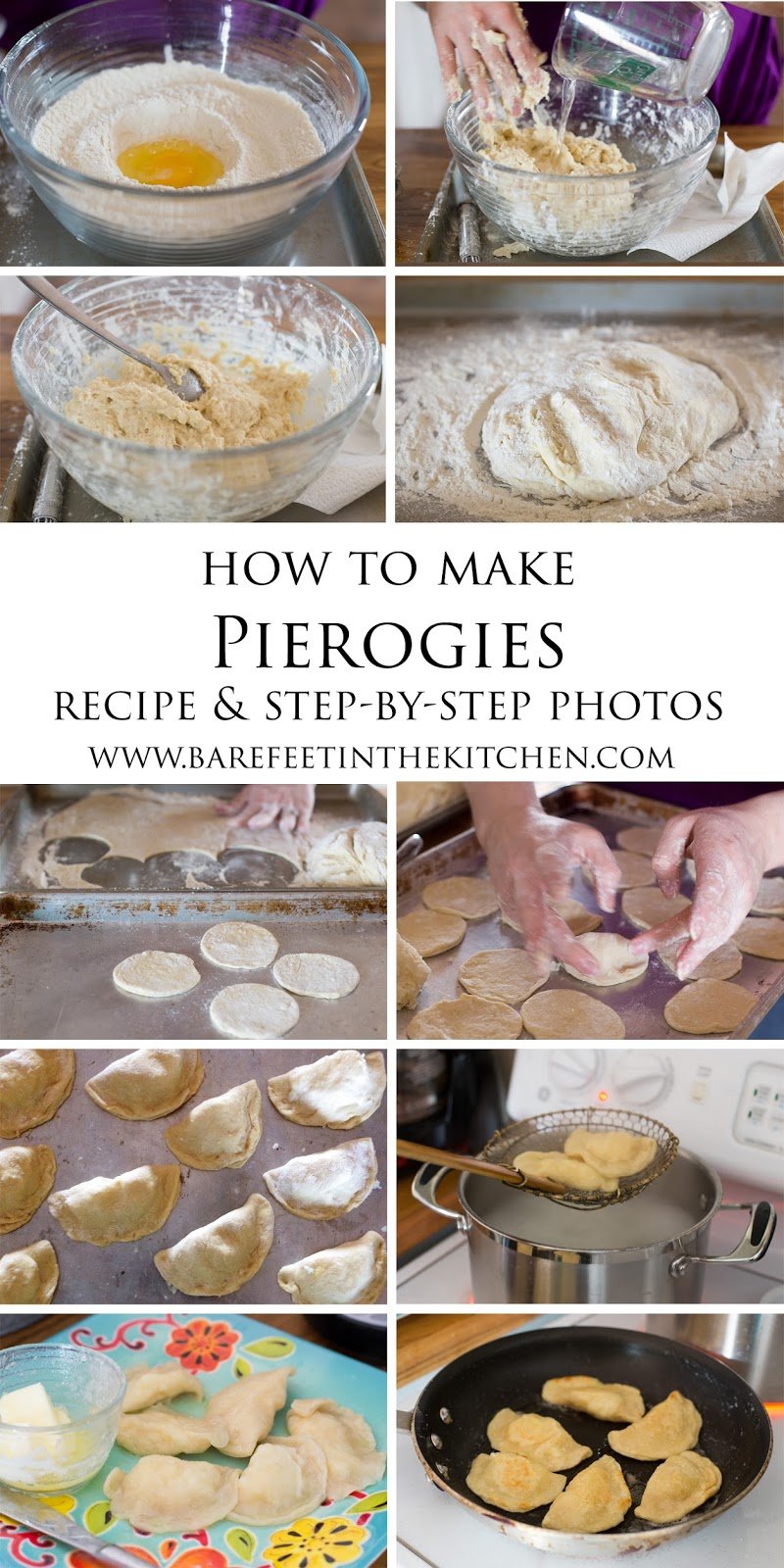
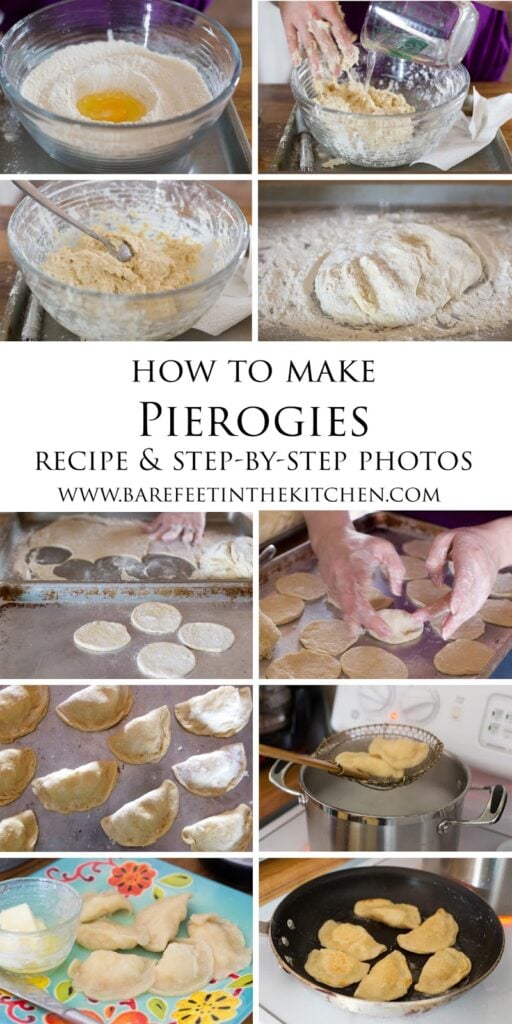
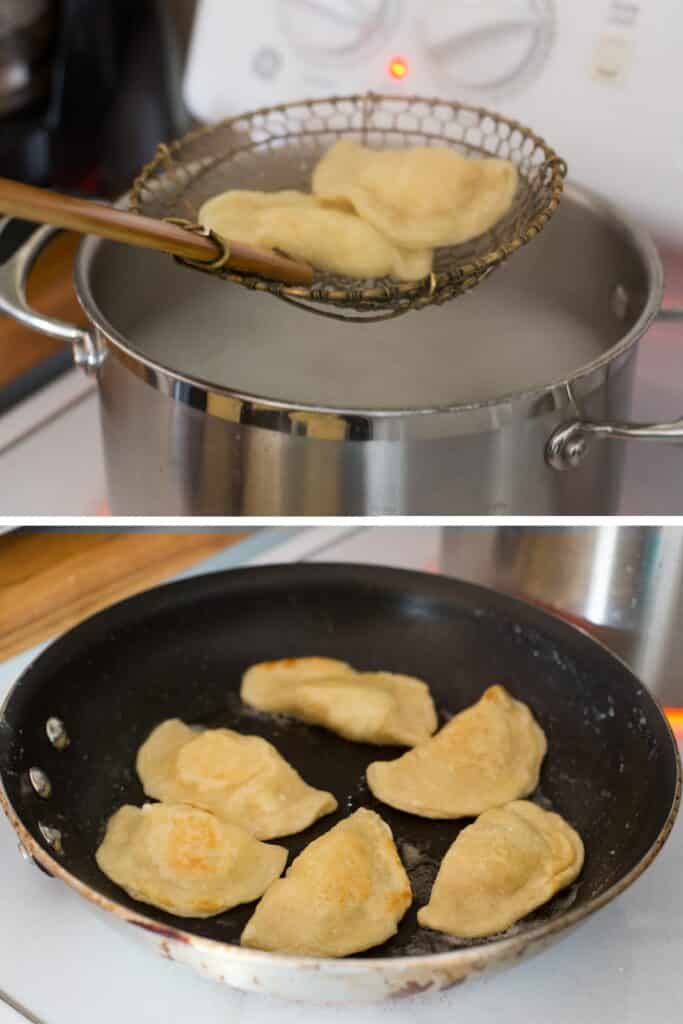



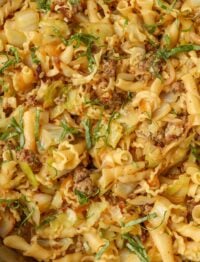

Teresa says
my grandmother passed the recipe down to my mother in return she taught 4 daughters to make these.And now I’m the only one that makes them for my family! It is alot of work but worth the time and the ah’s of thanks mom!
Mary Younkin says
I love all of the memories associate with pierogies, Teresa. They’re certainly a labor of love.
Keith N says
I’ve made this recipe and it’s the one I always use. I belong to a Facebook group for Polish cuisine. There’s often debate about whether you should use an egg or not when making the dough for pierogies. After reading this article and making pierogi dough without an egg, I’m now in the camp that says don’t use an egg. I advise all of you to make this recipe just as it is but substitute 2 tablespoons of butter for the egg. I think you’ll like the results.
Mary Younkin says
I’ll have to try that next time and see how it works. Glad you like the recipe, Keith.
Keith N says
Mary, if you substitute 2 tablespoons of butter for the egg when making the pierogi dough, take the water you would use for the dough and put it into a small frying pan. Add the 2 tablespoons of butter and heat them until the butter melts but not necessarily to boiling. Just melt the butter and stop there. Then just pour it into a mixing bowl with the salt and dough in it and mix the dough. That’s all you have to do. Then just proceed to the next steps in your recipe.
Kirsten says
Do you have a ground chicken pierogi recipe?
Thank you!
Mary Younkin says
I don’t have one specifically for ground chicken, but I’ve found that you can fill pierogi however you like best.
Beverly G says
When I would go to visit relatives in Pennsylvania, I would always bring back dozens of perogies. They would be filled with potato, or cheese or sauerkraut. I am looking for a just cheese perogie recipe. The cheese perogies that I had were sweet. Do you have a cheese recipe?
Mary Younkin says
Hi, Beverly. I don’t think I’ve made pierogies with just cheese before; unfortunately, I don’t have a recipe for that on my site. I’m sure it wouldn’t be too hard to work out, though; if you decide to try making the pierogies that way, let me know how they turn out! Happy cooking.
Cindy says
Use Farmer’s Cheese. That’s how my grandmother made them. The recipe I have calls for 1 lb. Farmer’s Cheese, 2 egg yolks (large eggs), 1 tsp. sugar & a pinch of salt to make 24 pierogi.
Maggie Perkinson says
This is my babci’s recipe for her cheese filling ( brought over from Poland in 1916. It’s the one we always used for cheese ones.
Babci’s Cheese Filling:
1 lb farmers cheese, 4 oz cream cheese ,1 egg
Preheat oven to 250ish and shut off. Crumble farmers cheese in a bowl or pan and put in the prewarmed oven for a while. Maybe 30-40 minutes. Until water drains from cheese. You are trying to dry out the cheese. Drain off water.Cool the cheese for about 20 minutes. Add cream cheese and one beaten egg.